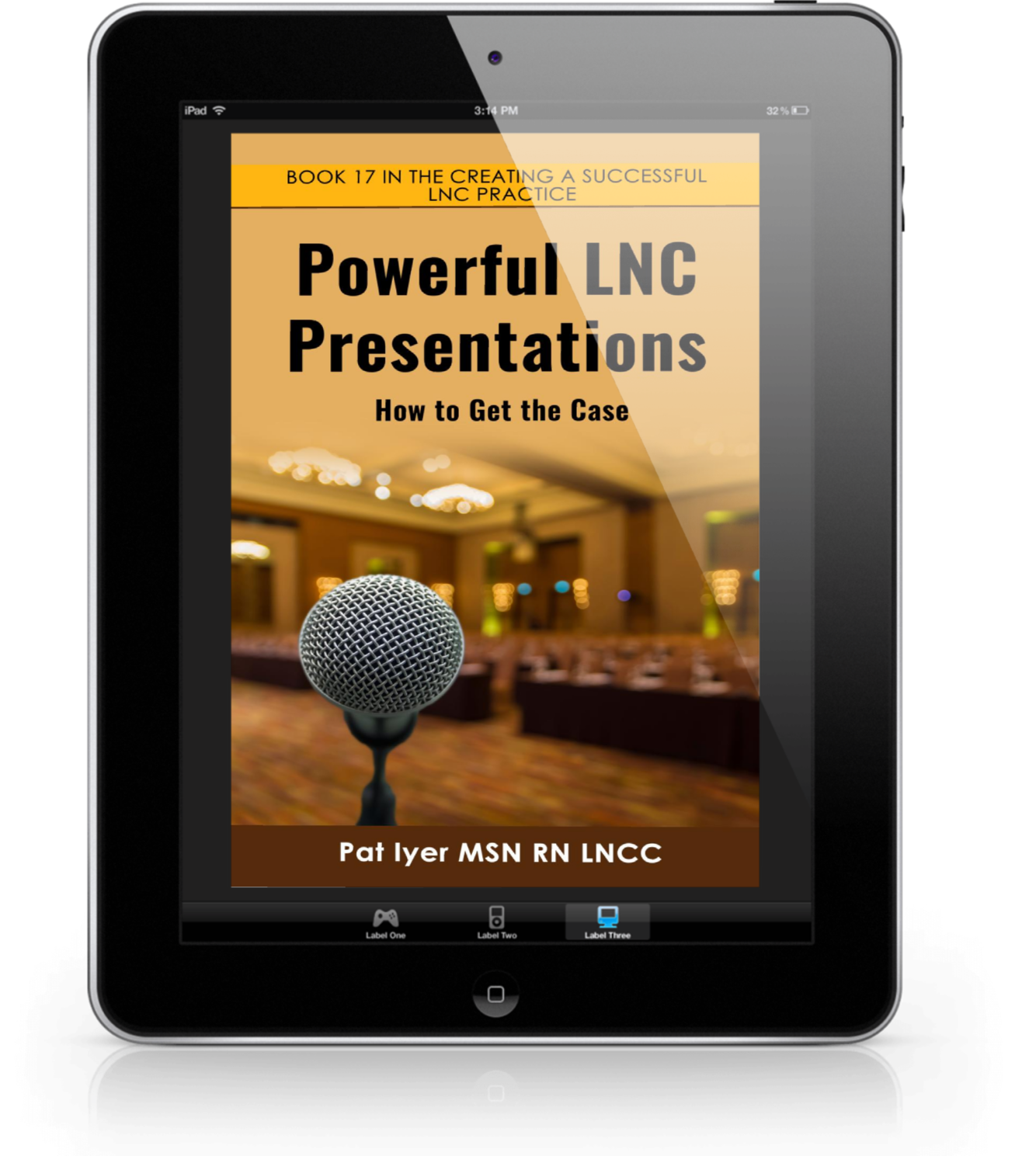Three Tips for Creating LNC Presentations for Attorneys

Want to listen to this blog? Click here to meet Trish, our AI assistant, who will read the blog to you.
Creating LNC presentations for attorneys is a wonderful way to get excellent exposure in front of attorneys.
When it’s time to present, remember that you’re ready, are prepared, and can do this. Talk to the audience, establish eye contact, and wait for and watch for audience reactions. Breathe and allow for silence, and keep your sense of humor. Speak deliberately and keep your body posture relaxed and observe your breathing.
Your presentation will be excellent, super professional, and engaging with the proper preparation. The attorneys in the audience will say, “I need to hire that LNC for my cases.”
Creating LNC Presentations for Attorneys
Kathleen Pagana, Ph.D., RN, contributed the following powerful suggestions, I modified and included them here.
Want to deliver a fabulous presentation for attorneys? Follow these three tips for a flawless presentation.
LNC Presentations Tip 1: Start with a bang
Spend a lot of time on how you start by thinking of ideas to catch people’s attention. Start with a bang. Grab people’s attention with your opening. How are you going to get their attention? Do you have an engaging story or a startling statistic?
For example, there are certain things that you shouldn’t do at the beginning of a presentation. I’m sure you’ve heard people say, “Today, I’m going to talk about.” It’s boring. It’s a bad way to begin. Or they apologize and say, “I’m sorry this topic is a little boring. Just bear with me.” I heard a doctor say that. I thought, “Just shoot me.”
Somebody said, “I’m sorry if it seems a little confusing. This presentation was dumped on me last night, so I didn’t have time to prepare.”
Beginnings like that set people off on the wrong foot. People think that you can start badly and build into it. Nothing could be less accurate. Dive right in.
“Just because people’s butts are in the seats doesn’t mean their brains are in the room.” Doug Stevenson.
LNC Presentations Tip 2: Cut it Down
When I started giving educational presentations to attorneys, I put too much content into my talk. This tactic is a beginner’s mistake. Speakers often overestimate how much their audience can retain. Experienced speakers suggest limiting your talk to three main points. Introduce your topic, make your three points, and summarize. Summarize the main points and the takeaways. Resist the urge to tell your audience everything you know about the topic. They need time to process your words before you conclude your presentation.
Do you believe more is always better? For example, do not create 100 slides for a 10-minute presentation. Seriously, I saw someone do this. Then she read the slides to the audience. Boring!
The speaker who gives into this temptation will speed through slides because “more is better.” That is entirely the wrong attitude. When a speaker exceeds the allowable time, the schedule gets thrown off. The meeting planner or moderator then needs to decide how to handle this by shortening someone else’s time. In an in-person event, breaks are timed to coincide with the arrival of coffee or food. Don’t be the speaker who creates this kind of trouble.
Cut your content by asking yourself, “What is the core message?” What do you want the audience to know when they leave? Suppose someone asked an attendee, “What was that LNC’s presentation about?” They should be able to say exactly what you talked about.
Tracking Time
Sometimes when you are presenting, you may run out of time. Maybe the program started late because the moderator made announcements, or you’re following somebody who went over time. You need to be able to cut your material back right on the spot. If you know your core message, you can adjust the length of your presentation as needed, trusting you’re conveying the critical information.
One way to do that when you’re putting your presentation for attorneys together is to have some must-know material, some should know, and some could know. You might color code it, and if you’re running out of time, you eliminate the “Could Know.” But if you also need to eliminate the “Should Know,” you can cut down your content.
Don’t worry, “What if I end early?”
People are delighted if you end early, so don’t think you must go to the last minute. It’s not effective.
LNC Presentations Tip 3: Never get angry during a presentation
No kind of anger belongs in a presentation. If your video clip doesn’t work, you say, “Sorry that didn’t work,” and you go on. I was at a presentation in Phoenix once where the speaker had a video, which didn’t work. She kept trying to get it to work, complaining to the people. “Get this working. It worked when we tried it an hour ago.”
Throughout the presentation, she kept referring back to it, saying, “If only you had seen the video.” It’s silly because, as audience members, we didn’t care what was in the video. We didn’t see it, so go on without it.
Be polished
Create your introduction in 14-size font and hand it to the moderator, asking them to read it exactly as you wrote it. You’d be surprised how easy it is for a moderator to mangle your introduction without your help. Even though I handed one of my clients my introduction, he misstated the name of my company when he introduced me. I subtly corrected this error during my talk.
- Don’t start your talk by thanking the moderator for inviting you. Get right into your subject. Your audience knows you are grateful to be there.
- Avoid filler words, the ums, ahs, you know, so, I mean.
- Vary your pace. Pause to allow attendees to process your critical points.
- Use gestures meaningfully. Point and open your hands to give emphasis. Avoid waving your hands to burn off energy.
- Don’t pace around the stage. Move to make a point. Our brains associate the left with something that happened first in a sequence. If you discuss something that happened in the past, move to your right, the audience’s left. When you discuss a point about something in the future, move to your left, the audience’s right.
- Even though there may be many in your audience, speak to one person. “Raise your hand if…” is preferable to “How many of you…raise your hand.” I’ve also changed this technique to say, “Stand up if you agree…” This technique gets people off their seats and gives them a boost of energy.
- Avoid profanity. Yes, some famous speakers use it as part of their brand. You are not in that category.
Wrap Up
I’ve assembled a handy free checklist, Presentation to Attorneys Checklist, which will ensure you do not overlook any aspect of getting ready for and delivering your presentation. Get it here.
Be sure to get my latest book in the Creating a Successful LNC Practice Series, Powerful LNC Presentations: How to Get the Case.

Pat Iyer is president of The Pat Iyer Group, which develops resources to assist LNCs in obtaining more clients, making more money, and achieving their business goals and dreams.
Pat’s related websites include the continuing education provided on LNCEU.com, the podcasts broadcast at podcast.legalnursebusiness.com, and writing tips supplied at patiyer.com.
Get all of Pat’s content in one place by downloading the mobile app, Expert Edu at www.legalnursebusiness.com/expertedu. Watch videos, listen to podcasts, read blogs, watch online courses and training, and more.




